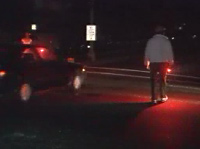
|
||||||||||||||||
|
|
|
Remembering Loma Prieta
So many people were calling to and from the Bay Area that the phone lines had been jammed for hours, leading to the mistaken impression that service had been knocked out. The first call I got was from my boyfriend, Jeff, who reached me from a cellular phone a little after 7 p.m. As Jeff and I were talking, my house rocked from a powerful aftershock, one of the more than 13 aftershocks of greater than 4.2 magnitude we would experience that night. About 10 seconds later, Jeff—40 miles away in San Jose—said he felt it, too. With no power in my house and no way to cook after I shut off the gas, I crawled into bed, fully dressed, in case I had to get out quickly. Sleep, however, proved elusive. Every time I drifted off, another aftershock would hit and fray my raw nerves a little more. I finally gave up and turned on my radio to listen to more disaster news. In addition to the damage in Santa Cruz and San Francisco, dozens of unreinforced masonry buildings in Oakland, Los Gatos, Hollister, and Watsonville had been destroyed. An elevated portion of Highway 1 between Monterey and Santa Cruz had collapsed, its support columns piercing the concrete roadway. The Embarcadero Freeway, which blocked the view of the bay from downtown San Francisco, was damaged beyond repair and was later torn down. Much of the reporting sounded unbelievable during that long, shaky night, and later proved false. Initial death estimates were in the hundreds; in fact, 69 people had lost their lives. At 2:00 in the morning, I heard that a tsunami had wiped out a block of oceanside restaurants in a nearby beach town. In reality, scientists recorded no unusual waves that night. The burning of the Marina district and the collapse of the Cypress Freeway were real, but hearing about these events on my little radio I could hardly conceive of these things happening. Even people who saw the news on TV, as I later did, had a hard time comprehending the enormity of the disaster. Because most people in the greater metropolitan area suffered little damage, it was especially surreal for them to watch or listen to the news. Then I started hearing about people coming together in neighborhoods, fighting fires, rescuing elderly people, and just helping each other cope. Emergency shelters and tent cities from Watsonville to San Francisco were staffed by volunteers. Citizens directed traffic at street corners that had lost power. Neighbors comforted neighbors they had never talked with before. People came together in ways that can only happen in the face of a crisis. Those commingled images of human vulnerability and strength are what remain of Loma Prieta. Every time a powerful earthquake strikes somewhere in the world, we're reminded of what it was like to live through our big one, and wonder when it might happen again. |
Live Eye • Great Shakes • Quake Basics • Damage Control • Active Zone




